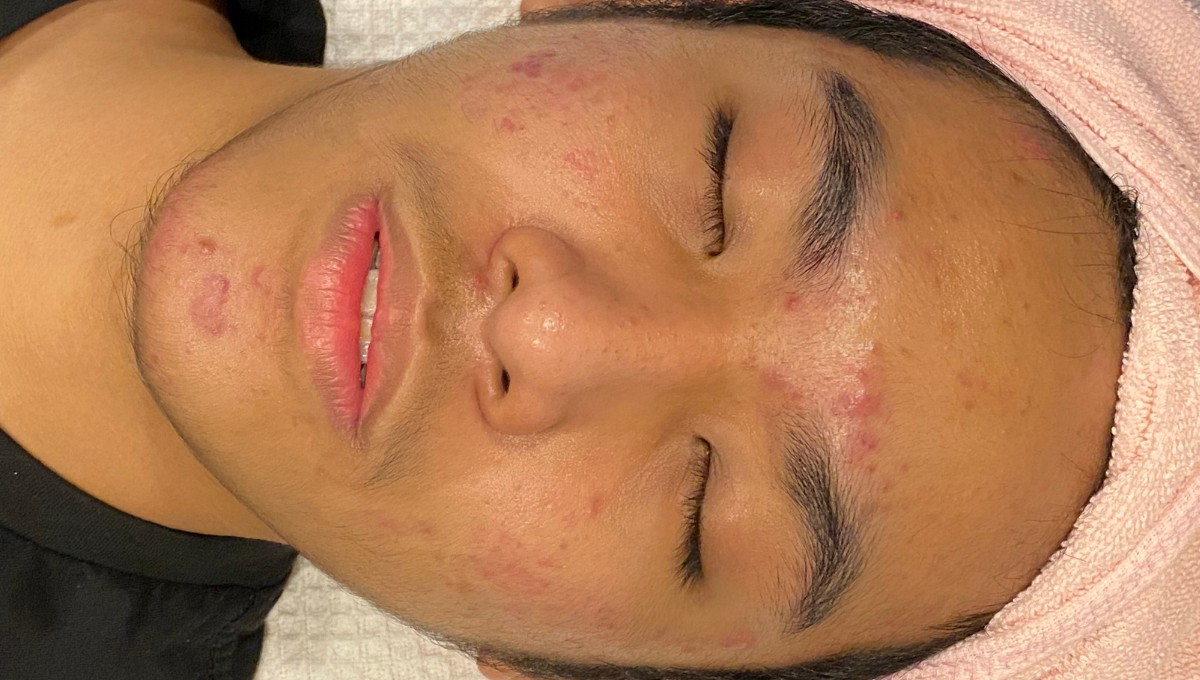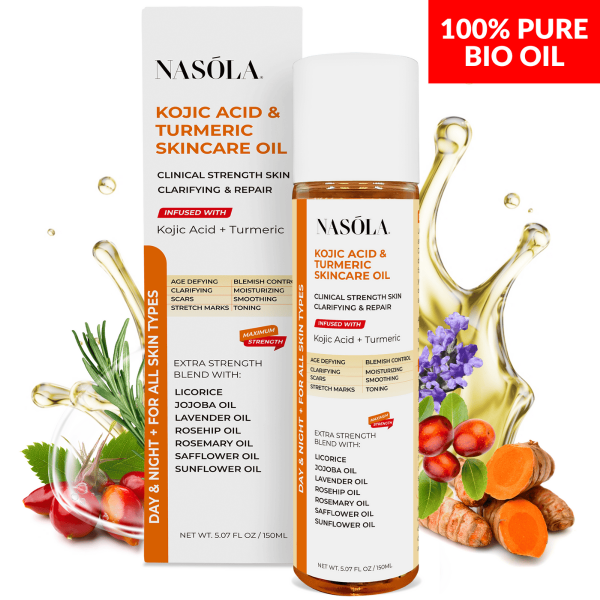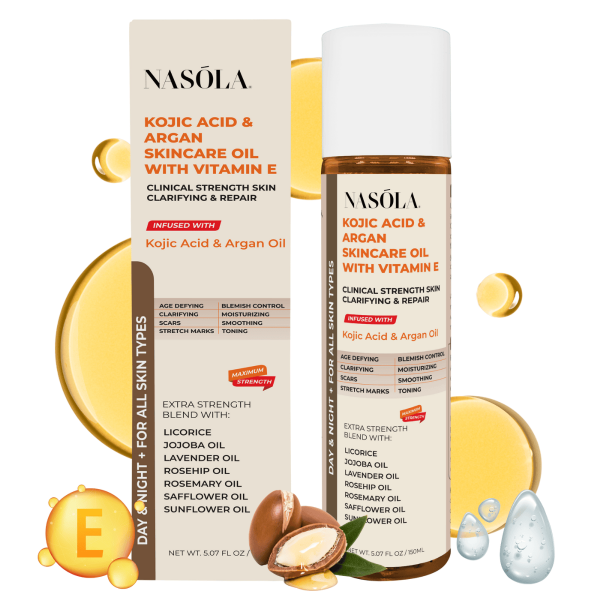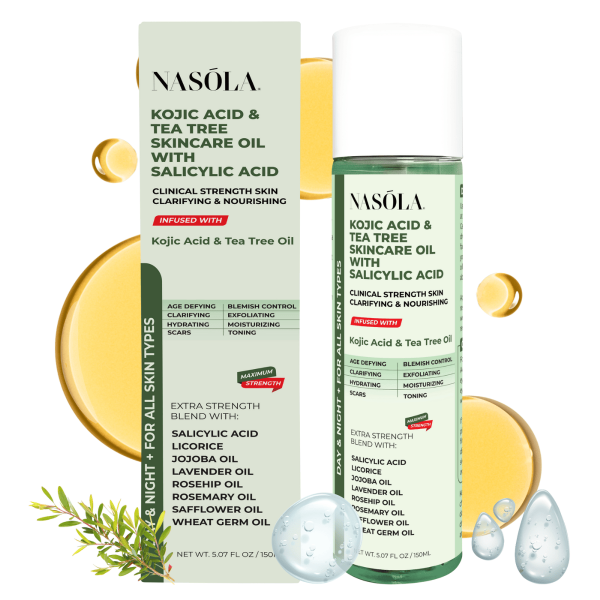If you’ve ever stood in front of a mirror, poking at yet another blemish while eyeing that tiny bottle of oil skeptically—you’re not alone. The idea of using the best face oil for acne almost feels like a contradiction, right?
But stay with us… because the truth flips the script.
Some face oils can actually help acne, not hurt it. Non-comedogenic, plant-based oils don’t clog pores. Instead, they nourish, heal, calm inflammation, and fade scars.
With the right formula—especially ones packed with kojic acid, tea tree oil, turmeric, or salicylic acid—your skin can start recovering, gently and beautifully.
In this blog, We’ll walk you through what truly works for all kinds of acne-prone skin: whether you’re oily, dry, super sensitive, or scarred.
And yes… We’ll reveal why Nasola’s Kojic Acid Skincare Bio Oils are beauty in a bottle—healing and hydrating while working under the skin to transform texture and tone.
So, ready to break up with breakouts?
Best Face Oil for Acne

Let’s get something straight—just because you have acne-prone skin doesn’t mean you need to run from face oils. The myth that oils cause breakouts? Debunked.
Many of the best face oils for acne are lightweight, anti-inflammatory, antibacterial, and packed with healing nutrients. It’s all about using oils that don’t clog pores—these are called non-comedogenic oils, and they’re skin-saviors.
Oils with acne-fighting properties do more than moisturize. Some help regulate sebum (the oily substance your skin naturally produces), calm enflamed breakouts, and fade the scars acne leaves behind.
Take kojic acid, for example—one of the heroes in Nasola’s acne-fighting lineup.
Nasola Kojic Acid Tea Tree Skincare Bio Oil with Salicylic Acid is truly a multitasker:
- Kojic Acid — reduces dark spots and pigmentation
- Tea Tree Oil — blasts acne-causing bacteria
- Salicylic Acid — unclogs pores and prevents future breakouts
- Fast-absorbing formula — great for day or night use
It’s basically a triple-threat for anyone actively battling acne.
If you’ve been burned by harsh acne treatments before (I see you, red flaky patches 👀), this gentle-but-powerful oil might just be your new skin BFF.
Start with 3–4 drops at night after cleansing, then press into your skin like the skincare queen—or king—you are.
Best Face Oil for Acne-Prone Skin
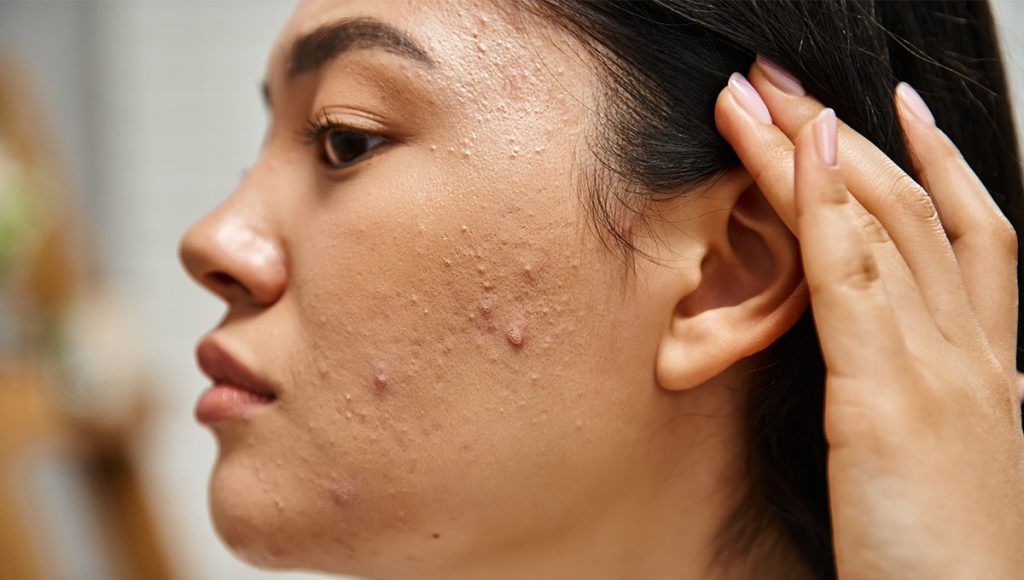
If the phrase “best face oil for acne-prone skin” makes you pause, that’s fair! After years of being told oil = evil, it takes a mental shift to realize the right formulation could clear your skin. But here we are!
This section dives into powerhouse oils like salicylic acid and tea tree oil—proven acne-fighters that don’t just prevent pimples… they improve skin over time.
Want your glow without the grease? You’re in the right place.
Salicylic Acid for Deep Cleansing
Salicylic acid—a true classic. And yes, it’s magical when infused in oil.
Even for the most stubborn acne-prone skin types, salicylic acid reaches deep into pores, exfoliates from within, and helps prevent future breakouts by eliminating trapped gunk (technical term 😉). Using it in a soothing oil base means less chance for drying or irritation.
That’s what makes Nasola Kojic Acid Tea Tree Skincare Bio Oil with Salicylic Acid a total game-changer. The salicylic acid works hard to:
- Gently exfoliate and unclog pores
- Reduce blackheads and whiteheads
- Control oil production
- Prevent new acne from forming
Mixing salicylic acid with anti-inflammatory tea tree and brightening kojic acid balances potency with care. You get results—without the wrecked skin barrier.
Tea Tree Oil to Kill Acne Bacteria
We can’t talk about natural acne solutions without spotlighting tea tree oil.
This antibacterial legend has been used for centuries, and it’s now backed by dermatologists and studies alike. Tea tree oil penetrates pores to fight acne-causing bacteria and even reduces the size of existing pimples—like, overnight.
Here’s the thing: pure tea tree oil can be too intense. But when it’s thoughtfully blended (like in Nasola’s Bio Oil), it becomes powerfully gentle:
- Fights acne bacteria without harsh chemicals
- Reduces redness and inflammation
- Aids in spot treatment without over-drying
- Combines well with kojic and salicylic for full-spectrum care
If your skin’s been begging for something effective but not aggressive, this oil might be exactly it.
Best Face Oil for Sensitive Acne-Prone Skin

Sensitive, acne-prone skin? Double whammy. Most treatments are either too harsh or too greasy, and your poor skin ends up stuck between “broken out” and “angry.”
But you don’t have to suffer. There are oils perfectly matched to calm, nourish, and gently fade marks—without setting off a flare-up.
Let’s talk argan oil, aloe, and calming botanicals.
Argan Oil for Gentle Moisture
Argan oil might be the most underrated gift from nature for sensitive skin warriors.
Rich in vitamin E, antioxidants, and essential fatty acids, it hydrates deeply without clogging pores. It’s light, fast-absorbing, and naturally anti-inflammatory—ideal for those moments your skin feels like it’s throwing a toddler tantrum.
The Nasola Kojic Acid Argan Skincare Bio Oil makes it even better by pairing argan oil with kojic acid:
- Light hydration that won’t clog sensitive pores
- Kojic acid brightens acne scars and discoloration
- Argan oil calms redness and soothes irritation
- Works well under makeup or at night
Your sensitive skin isn’t a problem—it just needs the right language, and this oil speaks it fluently.
Aloe Vera and Botanical Oils to Calm Skin
Plant-based doesn’t mean weak—it means your sensitive skin has a better shot at peace.
When flare-ups become frequent, aloe vera and botanical blends like chamomile or calendula can soothe deeply without disrupting your skin’s protective barrier. Aloe-based oils are especially beneficial for those with inflammation-driven breakouts or patchy dry areas.
Look for oils that combine:
- Aloe vera for hydration and inflammation relief
- Chamomile to reduce redness
- Vitamin E to support repair
- Argan or jojoba oil as non-comedogenic nourishers
The gentler, the better—especially for day-to-day hydration and recovery after breakouts.
Acne Scars and Acne-Prone Dry Skin
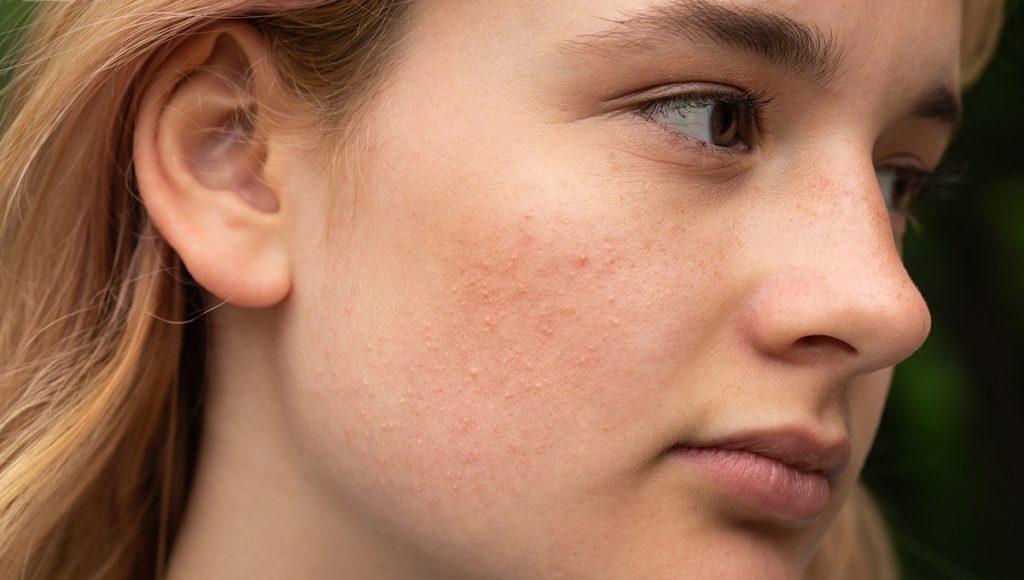
Let’s be real—fading acne is just Step One. Scar city? That’s where we lose sleep.
And if your skin is also dry AND acne-prone?? That’s the skincare Bermuda triangle. But with the right bio oils, you can treat lingering scars while locking in the hydration dry skin craves.
Turmeric for Fading Scars
Turmeric isn’t just a kitchen staple—it’s a skin-brightening MVP. This golden root is rich in curcumin, a compound proven to reduce pigmentation, scars, and inflammation.
It boosts radiance and fades stubborn post-acne marks (the kind that love to hang around). And when turmeric’s paired with kojic acid? It’s chef’s kiss 👌
That’s why Nasola Kojic Acid Turmeric Skincare Bio Oil is hands-down one of the best natural oils for acne-prone skin. Inside, it’s got:
- Kojic acid to reduce melanin production
- Turmeric extract to target discoloration
- Fast-absorbing oil to layer under moisturizer
- Lightweight hydration with heavy-lifting results
Using 3 drops nightly can speed up scar recovery and brighten tone in just a few weeks.
Hydrating Oils for Dry, Acne-Prone Skin
Most acne skincare targets oiliness, but what about those of us with flaky yet breakout-prone skin?
Oil-stripping products just make things worse for dry/acne-prone types. What you actually need is a hydrating formula that also treats acne.
Here’s what to look for:
- Plant oils (like jojoba or argan) that mimic natural skin oils
- Anti-inflammatory ingredients to calm breakouts
- Emollient support to improve texture and reduce flakiness
- Acne-fighting compounds like turmeric, tea tree, or licorice root extract
Nasola’s Kojic Acid Turmeric Bio Oil fits the bill beautifully. It hydrates, smooths, and fades scars without the heavy feel most oils have—aka hydration that heals.
Oils with Acne-Fighting Properties

It’s not just about hydration—it’s about oil with a mission! Yup, the best face oils for acne are functional multitaskers.
When ingredients like tea tree, turmeric, and kojic acid are fused into one bottle? You’re covering every acne symptom at once: breakouts, redness, dark spots… all of it.
Look for oils that combine:
- Antimicrobial properties (tea tree or neem)
- Brighteners (kojic acid, turmeric)
- Exfoliants (salicylic acid for clear pores)
- Moisturizers (like argan oil)
Nasola’s Tea Tree and Turmeric Bio Oils deliver:
- Protection against new breakouts
- Treatment for scars and marks
- Smoother, more balanced skin texture
- Antibacterial and brightening synergy
These oils do more—with less guesswork. If your skincare shelf is overflowing, streamline it with targeted bio oils that multitask like pros.
Best Natural Oils for Acne-Prone Skin
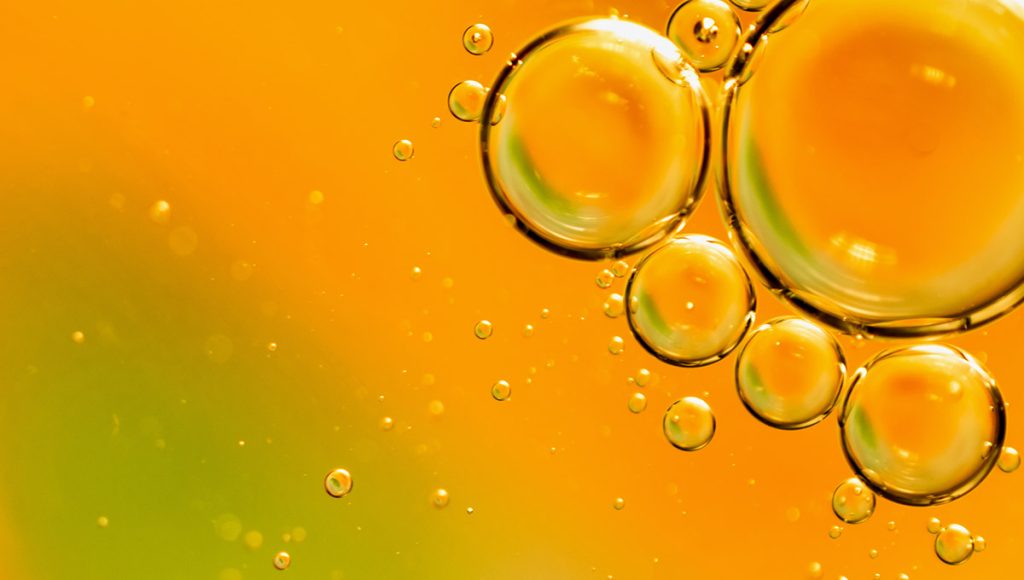
When we say “natural oils,” we don’t mean basic. We mean bio-active, skin-changing, and science-backed.
The best natural oils for acne-prone skin combine gentle botanicals and potent ingredients like kojic acid—a natural byproduct from rice fermentation, loved for its spot-fighting power.
Why kojic acid shines:
- Gently fades dark spots
- Helps even skin tone
- Naturally reduces melanin buildup
- Works on all skin tones
Nasola’s range makes it easy:
- For active breakouts: Nasola Kojic Acid Tea Tree Bio Oil with Salicylic Acid
- For sensitive skin: Nasola Kojic Acid Argan Bio Oil
- For scars and dryness: Nasola Kojic Acid Turmeric Bio Oil
Clean beauty meets clinical ingredients—and they don’t just coexist, they collaborate.
Ingredient Spotlight: Kojic Acid

Let’s nerd out for a second on something magical: kojic acid.
It comes from fermenting rice, soy, or mushrooms—and it inhibits tyrosinase, the enzyme responsible for excessive melanin. Translation? Fewer dark spots and a smoother complexion over time.
Benefits of kojic acid in face oil form:
- Reaches deeper skin layers gradually
- Lightens hyperpigmentation safely
- Supports even tone without bleaching or irritation
- Pairs well with tea tree, argan, turmeric, and salicylic acid
And when combined with nourishing carrier oils, it transforms your skincare from reactive chaos to intentional balance. No harsh bleach. No drama. Just a clear path to confidence.
Conclusion
There you have it—face oils that don’t just work, they transform. Finding the best face oil for acne isn’t a gamble when you understand what ingredients are doing behind the scenes.
Whether you’re battling breakouts, stressed from scarring, or frustrated over flare-ups, nature’s got a bottle for that. And Nasola’s Kojic Acid Bio Oils bring nature and science together to fight acne from all fronts: breakouts, redness, dark spots, and dryness.
Your skin deserves safe, radiant skincare.
So… ready to kiss trial-and-error goodbye? 🌿
Explore:
- Nasola Kojic Acid Tea Tree Bio Oil with Salicylic Acid
- Nasola Kojic Acid Argan Bio Oil
- Nasola Kojic Acid Turmeric Bio Oil
The solution could be just one drop away ✨
Frequently Asked Questions
Yes, if you’re using non-comedogenic, acne-safe oils. Look for formulas with benefits like tea tree, turmeric, or kojic acid. These oils manage sebum, fight acne-causing bacteria, and even fade old scars—instead of clogging pores like thick mineral oils.
One of the top choices is Nasola’s Kojic Acid Tea Tree Skincare Bio Oil with Salicylic Acid. It blends antimicrobial tea tree oil with exfoliating salicylic acid and brightening kojic acid, making it perfect for breakout-prone skin.
Sensitive types can benefit from the Nasola Kojic Acid Argan Bio Oil. It’s lightweight, calming, and packed with nourishing argan oil and gentle kojic acid, helping to hydrate and repair without irritating the skin.
Absolutely! Oils like turmeric and kojic acid are effective at reducing acne scars and post-inflammatory hyperpigmentation. A blend like Nasola’s Kojic Acid Turmeric Bio Oil can brighten patchy areas and smooth texture with regular use.
Not when you use non-comedogenic oils like tea tree, argan, or jojoba. Formulas from Nasola are designed to hydrate and treat skin without clogging pores, helping instead to balance your natural oil production over time.
Avoid heavy or comedogenic oils like coconut or wheat germ oil. Also say no to synthetic fragrances, petroleum-based ingredients, and alcohols that can dry or irritate acne-prone skin.
Start by using your face oil 3 to 4 times a week in the evening. Once your skin adjusts, you can increase to daily use. Always apply on clean, damp skin and follow up with a moisturizer if needed.
Yes! Nasola’s Kojic Acid Bio Oils are crafted with balanced concentrations to be safe for consistent use, even on sensitive or acne-prone skin. Gentle, effective, and daily-friendly.
They can complement—if not replace—most topical treatments, especially if your skin reacts negatively to harsh creams or drying cleansers. Bio oils soothe and treat simultaneously.
Try the Kojic Acid Turmeric Bio Oil for its dual focus on fading scars and deeply hydrating dry, flaking skin. It’s a recovery hero packed into one golden glow-up bottle.

